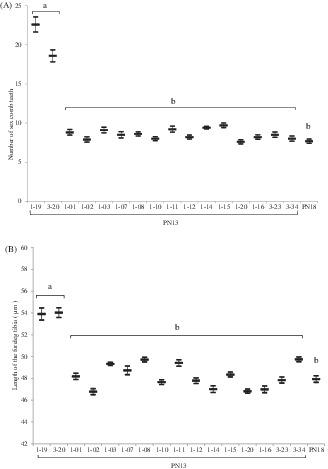当前位置:
X-MOL 学术
›
Entomol. Sci.
›
论文详情
Our official English website, www.x-mol.net, welcomes your
feedback! (Note: you will need to create a separate account there.)
Long‐term coexistence of a hybridization‐derived population of Drosophila parapallidosa with closely related Drosophila ananassae ( Diptera: Drosophilidae )
Entomological Science ( IF 0.7 ) Pub Date : 2020-09-29 , DOI: 10.1111/ens.12441 Yosuke Hama 1 , Chow‐Yang Lee 2, 3 , Muneo Matsuda 4 , Yoshitaka Kamimura 5 , Kyoichi Sawamura 6
Entomological Science ( IF 0.7 ) Pub Date : 2020-09-29 , DOI: 10.1111/ens.12441 Yosuke Hama 1 , Chow‐Yang Lee 2, 3 , Muneo Matsuda 4 , Yoshitaka Kamimura 5 , Kyoichi Sawamura 6
Affiliation

|
A 2012–13 survey on Penang Island, Malaysia, revealed the existence of both Drosophila ananassae and Drosophila parapallidosa, the latter of which carries chromosomes Y and 4 from D. ananassae and thus is of hybrid origin. We collected the flies again from the same location in 2018. The hybrid population remained present, which suggests that the D. parapallidosa of hybrid origin does not represent a mere transient population but is stable. Why do these two species coexist irrespective of gene flow? We realized that body size is generally larger in D. ananassae than in D. parapallidosa, which constitutes a new character with which to discriminate these species; previously the number of sex comb teeth was the only diagnostic trait. Character displacement was not detected, however, for those traits. We crossed these two species, which resulted in offspring that had an altered genomic constitution. The body size of D. ananassae was dominant, and the presence of chromosomes Y and 4 did not have a significant effect on body size. By contrast, the presence of chromosome 4 from D. ananassae significantly affected the number of sex comb teeth. Even flies having a genomic constitution similar to that of the Penang D. parapallidosa exhibited a number of sex comb teeth that was intermediate between the two species. We propose that the D. parapallidosa sex comb character underwent selection during evolution of the Penang Island population. Reproductive interference between the species, presumably caused by signal jamming, was detected.
中文翻译:

杂交衍生的 Drosophila parapallidosa 种群与密切相关的 Drosophila ananassae(双翅目:果蝇科)的长期共存
2012-13 年在马来西亚槟城岛进行的一项调查揭示了 Drosophila ananassae 和 Drosophila parapallidosa 的存在,后者携带来自 D. ananassae 的 Y 和 4 号染色体,因此是杂种来源。我们在 2018 年再次从同一地点收集了果蝇。杂交种群仍然存在,这表明杂交起源的 D. parapallidosa 不仅代表短暂的种群,而且是稳定的。为什么这两个物种无论基因流动如何共存?我们意识到 D. ananassae 的体型通常比 D. parapallidosa 大,这构成了区分这些物种的新特征。以前,性别梳齿的数量是唯一的诊断特征。然而,对于这些特征,没有检测到字符位移。我们穿越了这两个物种,这导致后代的基因组结构发生了改变。D. ananassae 的体型占优势,Y 和 4 号染色体的存在对体型没有显着影响。相比之下,来自 D. ananassae 的 4 号染色体的存在显着影响了性梳齿的数量。即使基因组结构与槟城 D. parapallidosa 相似的果蝇也表现出许多介于这两个物种之间的性梳齿。我们建议 D. parapallidosa 性梳特征在槟城岛种群的进化过程中经历了选择。检测到可能由信号干扰引起的物种之间的生殖干扰。Y 和 4 号染色体的存在对体型没有显着影响。相比之下,来自 D. ananassae 的 4 号染色体的存在显着影响了性梳齿的数量。即使基因组结构与槟城 D. parapallidosa 相似的果蝇也表现出许多介于这两个物种之间的性梳齿。我们建议 D. parapallidosa 性梳特征在槟城岛种群的进化过程中经历了选择。检测到可能由信号干扰引起的物种之间的生殖干扰。Y 和 4 号染色体的存在对体型没有显着影响。相比之下,来自 D. ananassae 的 4 号染色体的存在显着影响了性梳齿的数量。即使基因组结构与槟城 D. parapallidosa 相似的果蝇也表现出许多介于这两个物种之间的性梳齿。我们建议 D. parapallidosa 性梳特征在槟城岛种群的进化过程中经历了选择。检测到可能由信号干扰引起的物种之间的生殖干扰。parapallidosa 展示了许多介于这两个物种之间的性梳齿。我们建议 D. parapallidosa 性梳特征在槟城岛种群的进化过程中经历了选择。检测到可能由信号干扰引起的物种之间的生殖干扰。parapallidosa 展示了许多介于这两个物种之间的性梳齿。我们建议 D. parapallidosa 性梳特征在槟城岛种群的进化过程中经历了选择。检测到可能由信号干扰引起的物种之间的生殖干扰。
更新日期:2020-09-29
中文翻译:

杂交衍生的 Drosophila parapallidosa 种群与密切相关的 Drosophila ananassae(双翅目:果蝇科)的长期共存
2012-13 年在马来西亚槟城岛进行的一项调查揭示了 Drosophila ananassae 和 Drosophila parapallidosa 的存在,后者携带来自 D. ananassae 的 Y 和 4 号染色体,因此是杂种来源。我们在 2018 年再次从同一地点收集了果蝇。杂交种群仍然存在,这表明杂交起源的 D. parapallidosa 不仅代表短暂的种群,而且是稳定的。为什么这两个物种无论基因流动如何共存?我们意识到 D. ananassae 的体型通常比 D. parapallidosa 大,这构成了区分这些物种的新特征。以前,性别梳齿的数量是唯一的诊断特征。然而,对于这些特征,没有检测到字符位移。我们穿越了这两个物种,这导致后代的基因组结构发生了改变。D. ananassae 的体型占优势,Y 和 4 号染色体的存在对体型没有显着影响。相比之下,来自 D. ananassae 的 4 号染色体的存在显着影响了性梳齿的数量。即使基因组结构与槟城 D. parapallidosa 相似的果蝇也表现出许多介于这两个物种之间的性梳齿。我们建议 D. parapallidosa 性梳特征在槟城岛种群的进化过程中经历了选择。检测到可能由信号干扰引起的物种之间的生殖干扰。Y 和 4 号染色体的存在对体型没有显着影响。相比之下,来自 D. ananassae 的 4 号染色体的存在显着影响了性梳齿的数量。即使基因组结构与槟城 D. parapallidosa 相似的果蝇也表现出许多介于这两个物种之间的性梳齿。我们建议 D. parapallidosa 性梳特征在槟城岛种群的进化过程中经历了选择。检测到可能由信号干扰引起的物种之间的生殖干扰。Y 和 4 号染色体的存在对体型没有显着影响。相比之下,来自 D. ananassae 的 4 号染色体的存在显着影响了性梳齿的数量。即使基因组结构与槟城 D. parapallidosa 相似的果蝇也表现出许多介于这两个物种之间的性梳齿。我们建议 D. parapallidosa 性梳特征在槟城岛种群的进化过程中经历了选择。检测到可能由信号干扰引起的物种之间的生殖干扰。parapallidosa 展示了许多介于这两个物种之间的性梳齿。我们建议 D. parapallidosa 性梳特征在槟城岛种群的进化过程中经历了选择。检测到可能由信号干扰引起的物种之间的生殖干扰。parapallidosa 展示了许多介于这两个物种之间的性梳齿。我们建议 D. parapallidosa 性梳特征在槟城岛种群的进化过程中经历了选择。检测到可能由信号干扰引起的物种之间的生殖干扰。











































 京公网安备 11010802027423号
京公网安备 11010802027423号